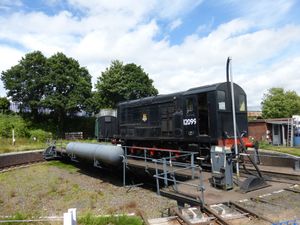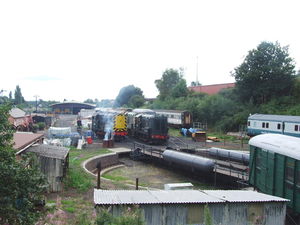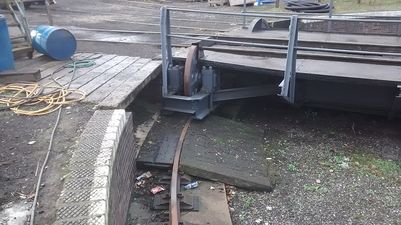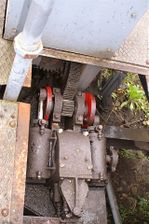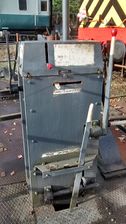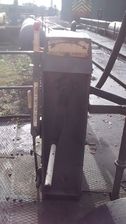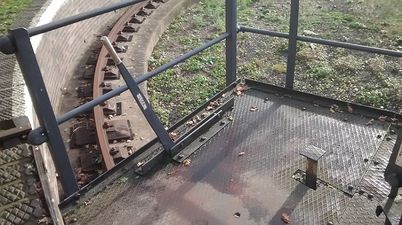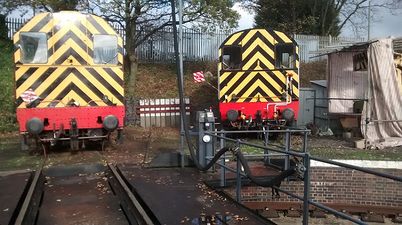Kidderminster Turntable
Kidderminster Turntable is situated between the Diesel Depot and the Kidderminster Footbridge. It was commissioned in autumn 1994. Ownership of the turntable was transferred from the Turntable Fund to the SVR Charitable Trust on 15 September 2009.[1]
Contents
Installation
The 70ft vacuum turntable was built by Cowans Sheldon and was originally installed at Fort William in 1948.[2] After decommissioning, it had resided for several years at Horsted Keynes on the Bluebell Railway before arriving on the SVR in June 1980.[3] Funds from an SVRA raffle were used to pay for the transport costs.[4]
The Railway originally planned to install it at Bewdley South in the Stourport Triangle[5], the fork between the Kidderminster and Stourport branches, but the development of Kidderminster led to its installation there instead. A track plan published shortly before Kidderminster opened in July 1984 showed a proposed site for the turntable on the station side of Kidderminster Footbridge[6], however the eventual location chosen was on the same side of the line (to the right when leaving the station) but a similar distance beyond the footbridge.
Fund raising to install the turntable began in the summer of 1991. In spring 1993 the SVRA Bristol Branch raffle "Spin-a-Loco in '93" raised £7,500 including donations.[7] The turntable was connected to the SVR network on 31 July 1994, with the 6 ton steam crane and match truck being the first items of rolling stock to be turned, followed by the "Red Ruston" diesel shunter. Installation was completed in time for the turntable to feature in that year's autumn steam gala. Visiting locomotive 60103 Flying Scotsman was turned on Friday 23 September as a prelude to the gala in a christening ceremony carried out by Lady Lucinda Lambton, although LMR 600 Gordon had already managed a turn on 9 September during an earlier 'Thomas' event. Other visitors 6024 King Edward 1 and 60009 Union of South Africa were turned on the Saturday and Sunday respectively. A further six months of work was then undertaken to complete the project.[8]
During the run up to installation a number of the large and small cast iron pads that support the ring rail were found to be missing. Patterns were made at the SVR's pattern-shop from original drawings and replacements were cast. With the SVR Charitable Trust more recently wishing to add some additional connections to the turntable the pattern set for the larger ring rail pads was refurbished at the Pattern Shop at Bridgnorth to allow further pads to be cast.
Operation
The turntable is driven by a vacuum motor, powered by the locomotive being turned. Two large vacuum reservoir cylinders can be evacuated in advance by a vacuum fitted locomotive to allow carriages or non vacuum fitted locomotives to be turned. In the event of no vacuum source being available, a cranking handle is provided.
Other SVR turntables
Another turntable ex-Whitchurch was already in the SVR’s possession in the 1990s, originally intended for installation at Bridgnorth[5]. This turntable is no longer at the SVR, reportedly now being in Mallaig, Scotland.
A third turntable was acquired in 1998 ex-Bristol (Bath Road). This is a 65ft 3in Ransom Rapier turntable built in 1957[9]. Pending a decision on where it should be installed, it was moved into storage at Eardington where it remains as of 2023[update]. It is eventually intended to become the Bridgnorth Turntable as part of the Bridgnorth Development Project.
North and South before the turntable
Most of the SVR's locomotives faced both north and south at different times before the turntable was commissioned in autumn 1994. Some turns were made on the main line, either as part of a rail tour or as a deliberate move for filming purposes. In later years locomotives also arrived back facing in a different direction after road moves involving loans to other railways.
46443 arrived on the SVR in steam in April 1967 facing south. In September 1969 it visited the Tyseley Railway Museum, piloted by a BR Class 47, and returned facing north, becoming the only SVR locomotive to face in both directions before opening day in May 1970. In early 1978 it was again piloted by a BR diesel when turned on the main line to face south for filming Hanover Street and The Thirty Nine Steps. Late in 1978 another piloted main line reversal was carried out to face north for filming A Man Called Intrepid.
In summer 1985 46443 made three visits to Bristol for running the Bristol to Portishead shuttles.[note 1] Only the first visit resulted in a reversal to face south again. 46443's final reversal to face north followed a day of operating main line shuttles on 26 September 1987 to mark the last day of the old Moor Street Station.
45110 arrived at the SVR in steam in August 1970 facing south. In August 1973 the locomotive attended a Derby Litchurch Lane Carriage Works "Open Day", travelling there and back in steam with LMS 24617 Corridor Composite, LMS 26986 Brake Third Corridor and Stove R 32919 and thereby becoming the first Severn Valley locomotive and rolling stock to work unassisted on the BR network in preservation. The formation was turned at Burton, with 45110 returning facing north.[10]
2047 Warwickshire was delivered to the SVR in October 1967 facing south. It attended the Town and Country Fair at Stoneleigh in August 1974 and returned facing north.
4566 arrived from Barry by rail in August 1970 facing south. In October 1976 it went to Tyseley for tyre turning and on return was intentionally turned to face north for filming Candleshoe. During its second boiler ticket it appeared at Port Sunlight for a Vintage Rail and Public Transport weekend and returned facing south again. Loans to the Gwili Railway in summer 1989 and Llangollen Railway in autumn 1993 resulted in two further turns to face north and south respectively.
The five SVR locomotives that attended Rail 150 in 1975 all returned facing in the same direction, with Gordon and 43106 being intentionally turned on the Bescot triangle to achieve this. Five SVR locomotives also attended Rocket 150 in 1980, although only one changed direction as a result. 80079, which had arrived on the SVR from Barry by rail in 1971 facing north, returned from Rainhill facing south. In summer 1993 80079 spent several months on loan to the Llangollen Railway, returning facing north. One further turn was achieved when the locomotive travelled south for 'Steam on the Met' in May 1994 and returned facing South.
4930 Hagley Hall arrived from Barry by rail in January 1973 facing north. After restoration, it made a number of main line appearances. In early 1981 during the spring 'Welsh Marches' season it returned for maintenance from its base at Hereford facing south; at the end of that season in April 1981 it returned facing north again. Another return for maintenance during the 1982 Welsh Marches season saw a further turn to face south. It returned in April still facing south, although the following month it was intentionally turned to face north for filming a Falstaff Cigars advertisement at Highley. A number of further rail tours took place between 1983 and 1986 of which only one resulted in a turn to face south, the 'GW 150 'Red Dragon' excursion to Swindon in February 1985.
7812 Erlestoke Manor had arrived on the SVR in April 1976 facing North. It took part in the spring 1982 Welsh Marches season with Hagley Hall and returned in April 1982 also facing south. In April 1983 it was turned to face north for filming The Weather In The Streets.
5690 Leander first arrived on the SVR as a resident in 1984 facing south. A visit to Didcot in autumn of that year resulted in a turn to face north. During the following summer Leander carried out main line work in Scotland and returned facing south again. In mid-1976 the locomotive made a final turn on the main line in order to face north when hauling the SVR 21st Anniversary train in July 1986.
6960 Raveningham Hall arrived in May 1977 facing south. In 1978 it became the SVR's first locomotive to work a main line railtour. However it was still facing south in December 1983 when it exchanged tenders with Hagley Hall, which at the time was facing north. With no turntable available, the two tenders were turned using a hired low-loader. 6960 was deliberately turned to face north in December 1984 to work a special through train double-headed with Hagley Hall. 6960's only rail tour which resulted in a turn to face south again was the 'GW 150' excursion to Chester in June 1985.
2857 arrived from Barry by rail in August 1975 facing north. Ten years later, in its only main line appearance, it hauled the 'GW 150' demonstration goods train to Newport in August 1976 and returned facing south. The locomotive spent 1992 on hire to the Gloucestershire Warwickshire Steam Railway and returned facing north again.
75069 arrived from Barry in 1973 facing south. It worked a number of main line rail tours between 1985 and 1987, only two of which involved a change of direction. It returned from the 'William Shakespeare' in April 1986 facing north, and after double-heading with Leander and a visit to Didcot, returned in mid-1986 facing south again. After overhaul it returned to the main line in 1981. In June of that year, it returned from weighing at Derby prior to the Cambrian Coast season facing north; at the end of that season it returned facing south again.
7819 Hinton Manor arrived from Barry in 1973 facing south. It worked on the main line from 1985 to 1991, although returning from the 1985 GW 150 celebrations and 1987 Cardigan Bay season facing in the same direction. In May 1988, following the Great Malvern station ceremony and tyre turning at Tyseley, 7819 finally returned facing north. A final turn to face south again came at the end of the Cambrian Coast season in late summer 1991.
'Jinty' 47383 arrived on the SVR by road in 1968 facing south. It remained that way until returning from a period on loan to the Swanage Railway in 1988 facing north. Two further periods on loan to Swanage in 1991 and the North Norfolk Railway in 1993 saw the Jinty return facing south and north respectively.
34027 Taw Valley arrived by road at Bridgnorth in August 1985 facing north. It worked regularly on the main line from 1989 to 1994, although these activities only resulted in two changes of direction, returning from the North Wales Coast specials in autumn 1989 facing south and from the London Marylebone specials in March 1990 facing north again.
3442 The Great Marquess arrived on the SVR in 1972 facing north. It worked on the main line regularly from July 1989, returning in April 1990 facing south. It remained that way until after the turntable was commissioned at the September 1994 Autumn Steam Gala, using the turntable for the first time in October of that year.
8F 48773 (formerly LMS 8233) arrived on the SVR in 1968 facing south. It returned from Rail 150 at Shildon in 1975 and from two excursions on the main line in 1987 and 1987 still facing south. However a visit to Derby in autumn 1991 for weighing and a loaded test run prior to resuming main line operations saw the locomotive facing north for the first time. It returned from the main line in October of that year facing south again. It changed direction to face north following a visit to the West Somerset Railway in 1993.
GWR Pannier 5764 (L95) and GWR Pannier 7714 arrived in 1971 and 1973 respectively. Both faced north from arrival until classmate 5775 arrived on hire from the Worth Valley in June 1993. 5775 was delivered facing south and the opportunity was taken to use the same low loader to turn 7714 so it also faced south. 5764, which was on loan to the South Devon Railway at the time, returned and was also delivered facing south, enabling the three panniers to carry out triple-heading during that year's Autumn Steam Gala.
46521 arrived in 1971 facing south. It turned only once, returning from a loan to the Gloucestershire Warwickshire Steam Railway in Autumn 1993 facing south.
Other items of rolling stock which turned before the turntable were:
- LMS coaches 26986, 24617 and 32919 with 45110 in August 1973
- The SVR's rake of 10 GWR coaches during the Paddington trip on 13 November 1976 (the only time the rake did not return facing in the same direction it left).
Locomotives which worked regularly on the SVR before 1994 but never changed direction before the commissioning of the turntable include 5164 (1979-1984 facing south), 7325 (from 1992 facing north), 42968 (from 1990 facing north), 43106 (from 1970 facing south), LMR 600 Gordon (from 1972 facing south) and WD 193 Shropshire (1971-1981 facing north).
Note
- ↑ Operationally 46443 could enter Bristol Temple Meads either from the west or routed to run via St Philip's Marsh and North Somerset Junction to enter the station from the east, so facing Portishead for the next service without running round. This had the effect of 46443 possibly turning direction regularly.
See also
List of infrastructure
Towards Kidderminster
Towards Bridgnorth
Kidderminster Station
Bridgnorth Turntable
